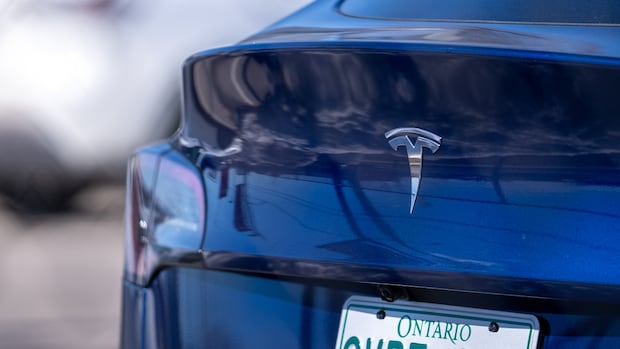A man from North Bay, Ont., says his teenage daughter failed her road test for her G driver's licence because she was driving his Tesla Model Y and only used the car's regenerative braking to slow down.
Electric vehicles and hybrids have the option to use regenerative braking, where the vehicle's electric motor is reversed and slows the vehicle to a stop.
"Essentially you can come to a full stop without even touching the brake pedal," said Eric Simard.
But Simard said his daughter failed because she never used the car's brakes.
He said his daughter was borrowing his car for the test, so she didn't know how to turn off the feature and was told she couldn't pause the test to call him.
Simard shared his daughter's road test results from Drive Test Ontario with CBC News. In them, the examiner marked a box indicating the vehicle was "out of order."
"I find it pretty frustrating because even though it's regenerative braking and you're not using the brake pedal, you're clearly the one that is in full control of making the vehicle come to a stop or to slow down," he said.
The regenerative braking only kicks in when the driver eases their foot off the accelerator pedal, which Simard argued shows intent to slow down at a specific time.
Simard added his daughter was also docked for a feature in his Tesla that chimes when a traffic light turns green.
In an email to CBC News, Julia Caslin, a spokesperson for Ontario's Ministry of Transportation, said the province's graduated licensing system "requires drivers to always demonstrate safe vehicle operation and full control, regardless of the vehicle's features."
"Applicants are expected to understand how their vehicle's system — including lane centring, regenerative braking, adaptive cruise control and automated parking — may affect handling and performance during a road test."
Caslin did not say if there are specific requirements to use a vehicle's brake pedal to come to a full stop if regenerative braking is also an option.
Simard said he posted about his daughter's experience in a Facebook group for Ontario Tesla owners, and some people reported they were fine using regenerative braking in their road tests. Others said their examiner asked them to turn off the feature.
The Drive Test Ontario website does not address the question, but does speak about another technology: rear-view cameras.
The website says drivers can use their rear camera during their road test, but must also show good observation skills.
"This means turning your head, checking mirrors and looking around while backing," the website says.
Saad Tariq, a driving instructor and owner of the Greater Sudbury Driving School, said he's not aware of any written rules banning the use of assistive technologies in Ontario road tests.
But Tariq said he discourages his students from using such technologies when he's teaching them.
"My vehicles that I teach in don't have blind-spot detectors, they don't have rear cameras," he said.
"So you actually have to look around and do all the basic skills yourself."
Tariq said that sensors on newer vehicles can easily be covered by snow or dirt in poor weather conditions, at which point they no longer work. In those cases, he said, it's especially important that drivers know how to handle their vehicles without them.
Amanda Lacroix, a driving instructor with the Northern Lights Driving School in the Levack community of Greater Sudbury, said she has mixed feelings about driver assistance technologies.
She said using driver assistance should be allowed for final road tests, for a G driver's licence, if the car that individual regularly drives uses those features.
"If the world's going to change and we're all going to have assisted driving, then we should be learning how to do it properly."
But Lacroix said she also agrees with Saad that drivers should know how to control their vehicles, and properly use their mirrors, even if their vehicles are equipped with the latest technology.













